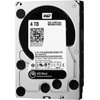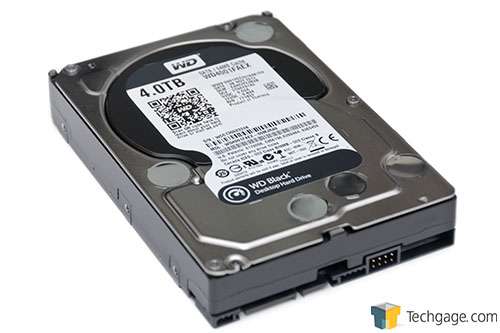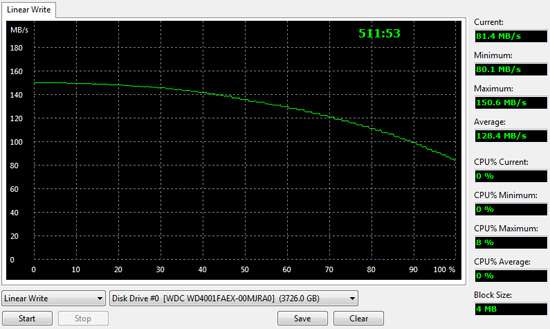- Qualcomm Launches Snapdragon 4 Gen 2 Mobile Platform
- AMD Launches Ryzen PRO 7000 Series Mobile & Desktop Platform
- Intel Launches Sleek Single-Slot Arc Pro A60 Workstation Graphics Card
- NVIDIA Announces Latest Ada Lovelace Additions: GeForce RTX 4060 Ti & RTX 4060
- Maxon Redshift With AMD Radeon GPU Rendering Support Now Available
WD Black 4TB Hard Drive Review

WD’s Black 4TB is the sort of product that doesn’t need much of an introduction – it speaks for itself. We’re dealing with a standard-sized desktop hard drive that sports a market-leading 4TB of storage. That’s 4,000GB, for those not paying enough attention. It’s impressive on paper, so let’s see how it fares in our benchmarks.
Page 1 – Introduction
As I begin writing this review, I find myself sitting here in awe that it’s a 4TB hard drive we’re dealing with. I had the same reaction when the first 1TB model hit the market, and likewise, the first 2TB model. 3TB seemed a little unimpressive given our progression up to that point, but 4TB – we’re talking 4,000 freaking gigabytes. Storage vendors have sure come a long way to be able to cram 4TB of storage into the same 3.5-inch form-factor we’ve been dealing with for eons.
See what I just did there? I managed to go the entire first paragraph without mentioning the “S” word. I’d like to think I’ve accomplished greater things in my life, but this one stands out.
With that over with, let’s talk about SSDs. Today, if you don’t place an SSD ahead of the mechanical storage in your PC, you’re doing it wrong. While the reasons are numerous for why an SSD is a better solution for your OS and applications, it boils down to performance, plain and simple. We’re not talking only about transfer speeds here, because those to me are fairly pointless in the grand scheme. What matters is access times, and SSDs have managed to cut those down to 1/100th or better versus mechanical storage. In many ways, an SSD is a better upgrade than a faster CPU (sorry, AMD and Intel).
That all being said, the “best” setup today is to have an SSD at the forefront – for things like the OS and applications – and then have mass storage at the back. For enthusiasts who want the best of both worlds – high density and high performance – I still heartily recommend WD’s VelociRaptor. Many people find it imperative to store their latest games on an SSD, but I’ve been using the VR 1TB full-time as a gaming drive since June and it’s performed just as well as I’ve ever seen an SSD perform for me gaming-wise. An exception you may find will be MMOs, which inherently load a brutal number of textures and objects all at once. It’s hard to compete with an SSD there.
So where, then, does WD’s Black series fall into place? Its goals are similar to the VelociRaptor, except it piles on the storage to a far greater degree while sacrificing performance. The 10K RPM vs 7.2K RPM speed differences are enough to show that. At current market rates, WD’s VR 1TB drive retails for just over $200. This 4TB Black? About $330. It’s roughly 50% more money for quadruple the storage at the expense of performance. For a lot of people, those trade-offs will be suitable.
| Density | Speed | Cache | SATA | Warranty | Usage | |
| VelociRaptor | 250GB – 1TB | 10,000 RPM | 64MB | 6Gbit/s | 5-year | Enthusiast |
| Black | 500GB – 4TB | 7,200 RPM | 32 – 64MB | 6Gbit/s | 5-year | Performance |
| Blue | 80GB – 1TB | 7,200 RPM | 8 – 64MB | 6Gbit/s | 2-year | Consumer |
| Green | 500GB – 3TB | ~5,300 RPM | 64MB | 6Gbit/s | 2-year | Storage |
| Red | 1 – 3TB | ~5,300 RPM | 64MB | 6Gbit/s | 3-year | NAS |
It may seem a bit strange that there exists a 4TB Black model but no 4TB Green model – and it kind of is. WD’s Green line had been the first to introduce flagship density models in the past, but for some reason the company decided to do things a little bit differently this time around. A theory I have for this has to do with the performance we’ll see from the 4TB Black through this review. Despite being a Black model, its performance sometimes comes closer to the Green – clearly proving that high-performance 4TB models are difficult to produce.
Because this is the case, the same drive running at ~5,300 RPM like the rest of the Green drives wouldn’t place it too kindly on our charts (you’ll see that the latency of the 4TB drive is actually worse than the Green 2TB, for example). I could be wrong, but I’m willing to bet we will not see other 4TB follow-up models from WD for at least six months. If there’s an update, it’ll likely involve 1TB platters, as the current Black 4TB is forced to employ 5x800GB platters.
This being the first 2TB+ internal drive I’ve reviewed, I’d like to talk for a moment about oddities I’ve encountered and other fun-facts.
Due to the fact that the MBR partitioning scheme limits hard drive density to 2.2TB, in order to properly use a larger model, GPT will need to be used. This limits its ability to operate with some older OSes, and may even cause issues otherwise. Iometer, for example, will not discover a GPT unpartitioned hard drive. This directly impacts our ability to use that tool and deliver what we feel to be totally accurate results.
AIDA64 is another benchmark that gave us some “odd” behavior. For drives under 2TB, the hard drive benchmarking tool defaults to 4KB file writes – a value we didn’t even know could be changed. It wasn’t until we benchmarked this 4TB Black that we noticed the tool automatically chose 4MB writes instead. Due to the size of the drive, this seems proper. Huge drives are used for storage, and that file size is about on par with an MP3 file, or RAW photo. The fact that it wrote 4MB chunks however meant that we couldn’t compare it directly to the other drives (it’d be like benchmarking a Ferrari on smooth asphalt and then again off-road). You might notice that in the screenshot above, 4MB writes across the drive took 511 minutes to run. Changed to 4KB, that number sky-rocketed to 6,500. You might be able to understand why we didn’t go that route.
Thanks to these two factors, we’ve been hit with the realization that we need to update our methodology just a wee bit. I’ll talk a lot more about this at a later date, but because HDDs are becoming more for storage than a house for your OS, there are definitely better ways we could be testing them. 4KB writes, for example, is a little irrelevant if you’re not going to be running applications on the drive.
None of these “issues” are the drive’s fault, but they’re interesting to note, and I’ll talk a bit more about them on the respective benchmark pages. On that note, let’s get on with that.
Support our efforts! With ad revenue at an all-time low for written websites, we're relying more than ever on reader support to help us continue putting so much effort into this type of content. You can support us by becoming a Patron, or by using our Amazon shopping affiliate links listed through our articles. Thanks for your support!







